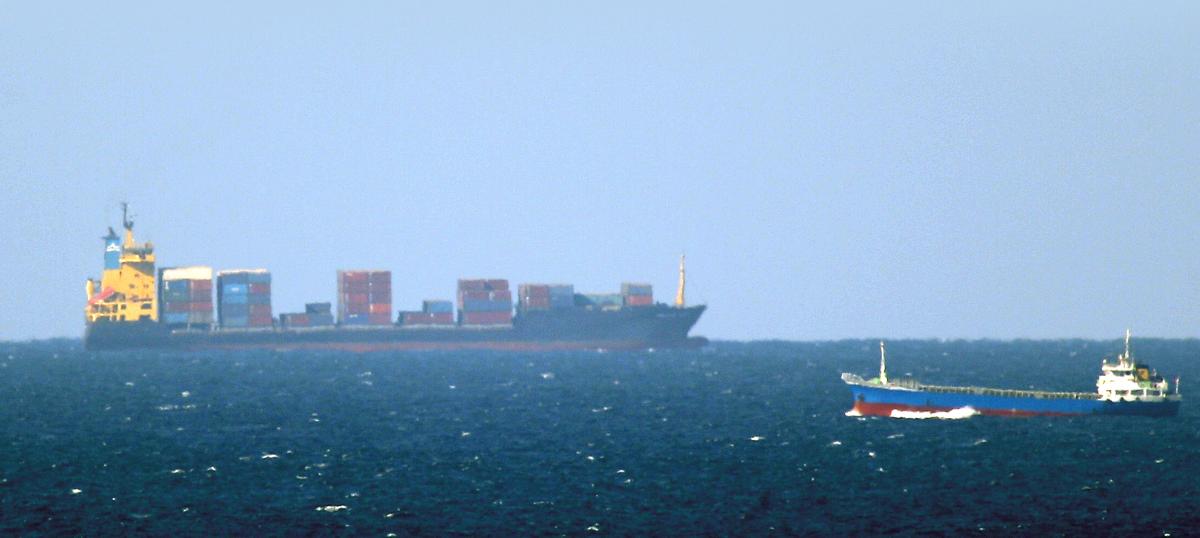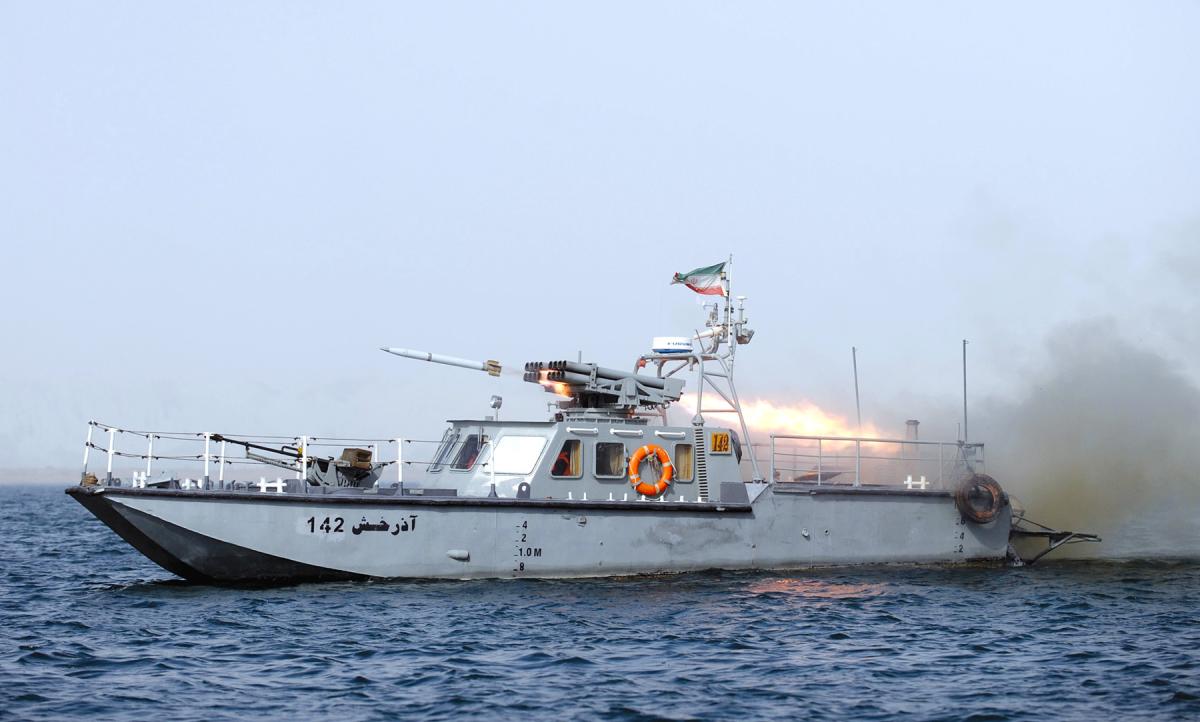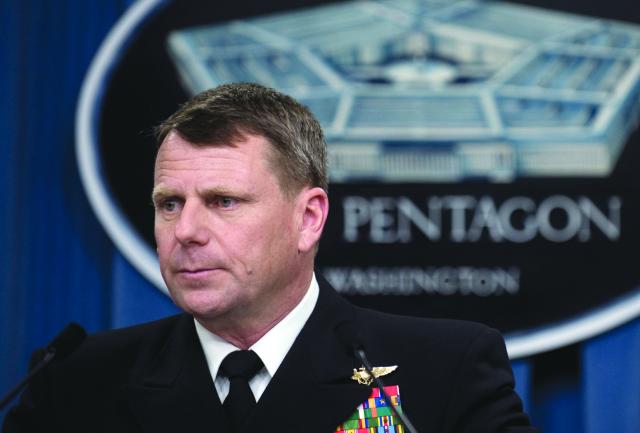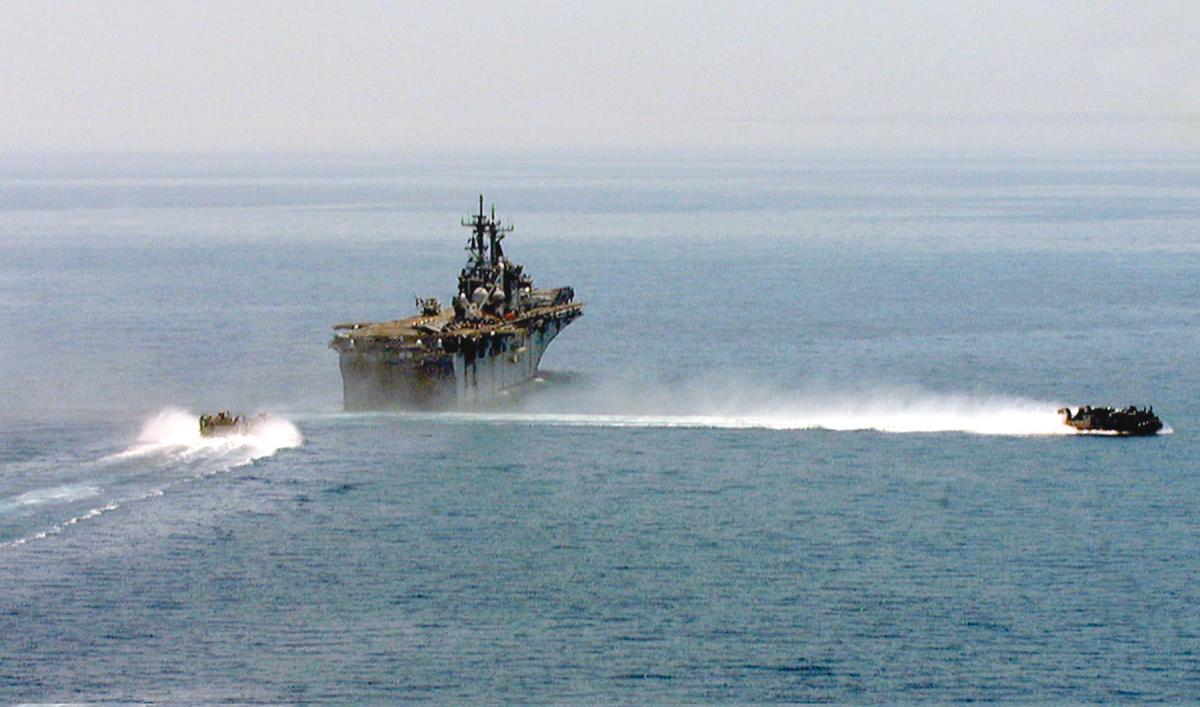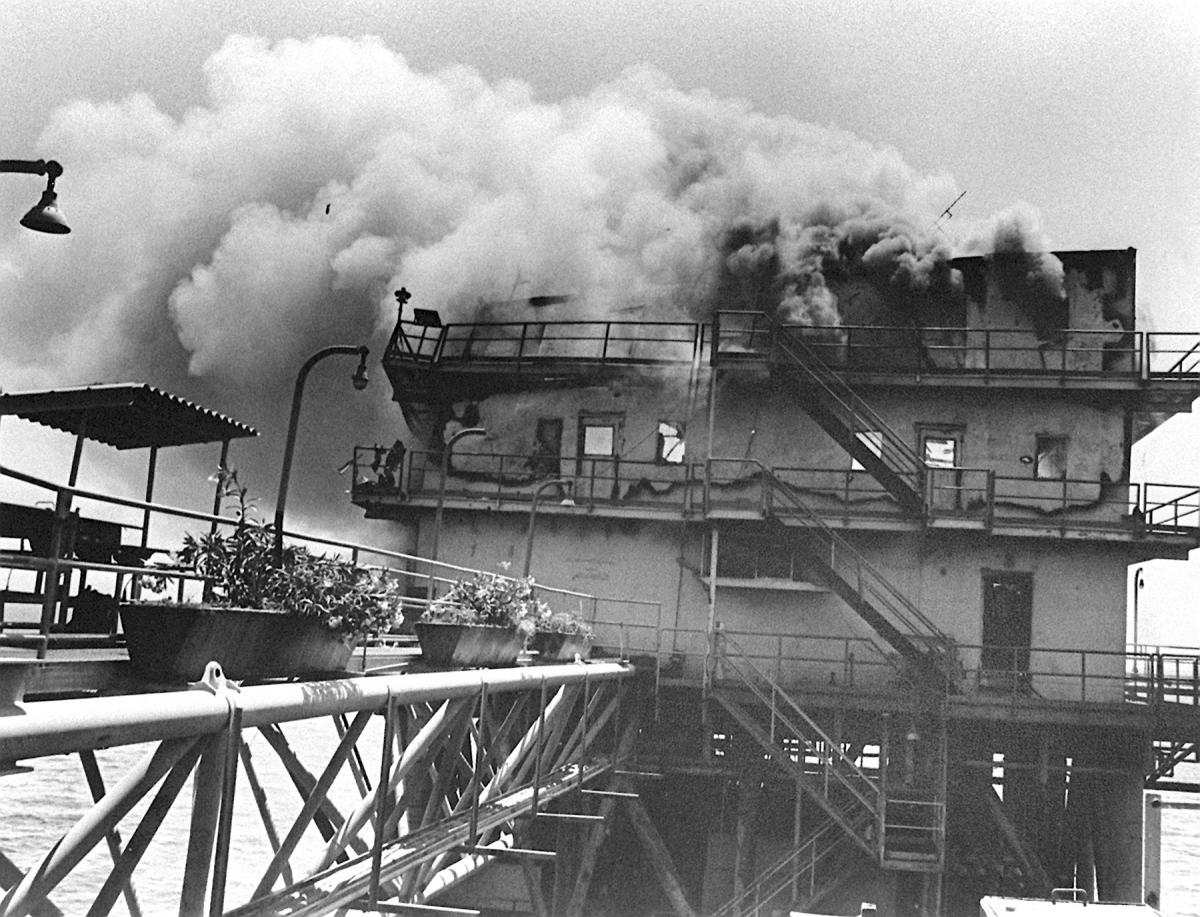In 2010, Dr. Shmuel Bar, director of studies at the Institute of Policy and Strategy in Herzliya, Israel, wrote the following:
Armor and in particular tanks had been the keys to Israeli success in previous wars. Following the battle of Bint Jbeil and the broadcast of destroyed Merkvas [Israeli “Chariot” tanks], the regional population knew that God’s Chariot, a symbol of power in the region for decades, was no longer invincible.1
The lessons of the 2006 Israeli-Hezbollah conflict, the 1987–88 Tanker War, and observations of recent developments in Iran offer insight into the scope and scale of what a potential conflict with Iran would hold for the U.S. Navy and its coalition partners. During the 2006 conflict in the Levant, Iran’s proxy Hezbollah executed a form of hybrid warfare that combined well-trained conventional forces, unexpected new weapons and tactics, and masterful exploitation of the information environment.2
Those events in Lebanon, when viewed as an extension of lessons learned from the 1987–88 Tanker War, demonstrate both Iran’s ability and willingness to wage a guerrilla war at sea using a mixture of conventional and irregular forms of warfare. A detailed analysis of the hybrid threat currently posed by Iran will reveal that a coalition naval force can defeat Iran, achieve desired objectives, and survive the experience only by selecting a strategy that uses reach and maneuver to its operational advantage.
Three Arguments
This analysis seeks to provide a recommended strategy built on the premise that a coalition force can better achieve its objectives by operating in the North Arabian Sea as opposed to risking operations inside the Persian Gulf. This strategy will be supported by advancing three arguments. First, a critical analysis of a prevailing school of thought that contends freedom of navigation through the Strait of Hormuz can and must be maintained during a conflict with Iran will show that approach to be flawed. Second, an examination of Iran’s current anti-access/area-denial (A2/AD) capabilities will illustrate that they can overwhelm even the most modern warship. Finally, this analysis will demonstrate that, despite the level of threat, a coalition force can defeat Iran’s A2/AD capabilities and achieve desired objectives in a regional limited conflict.
Contrary to the option of remaining outside the Persian Gulf and using the tactical advantages of reach and mobility, U.S. Navy strategists predominently contend that transiting the strait in a time of conflict is a manageable risk. It is noteworthy that one of U.S. Naval Forces Central Command’s (USNAVCENT’s) standing mission objectives is “to ensure the free flow of commerce in the Arabian [Persian] Gulf.”3 Backing up this objective is the Navy’s commitment to exercising and maintaining freedom of navigation through international waters, even when risk is involved. Further supporting this objective is a foundation of naval tradition and international law.
An example of how this paradigm is infused in the doctrine, praxis, and culture of coalition forces operating in this region is reflected in the comments of Captain David Adler, commanding officer of the USS Port Royal (CG-73). Captain Adler made this statement following the widely publicized December 2007 incident involving aggressive maneuvers of Iran Revolutionary Guard Corps Navy (IRGCN) small boats in the strait: “[T]he U.S. Navy’s regular transit through the Strait of Hormuz is to support regional stability. We’re here with the 19 other Coalition countries to keep the sea lanes open for international traffic.”4
Captain Adler’s comment was echoed in the press by then-USNAVCENT commander Vice Admiral William Gortney. When queried at a 2009 press conference about the incident, he concluded that the ships harassed by the IRGCN followed correct procedures and “had every right to be there.”5 These remarks regarding the incident reflect the application of USNAVCENT’s mission objectives to uphold the international law of the sea and the long-standing traditions of the U.S. Navy.
Three Assumptions
Political and economic pressures are also being applied to support the option of keeping the strait open regardless of the level of conflict in the region. These arguments are built, all or in part, on the following three assumptions:
• The Iranians cannot afford to shut down the strait.
• A coalition force will be able to keep the strait open through the use of superior force.
• Iran is militarily incapable of shutting down the strait.
In response to the rising tensions in the gulf during recent years, many global business and professional organizations have weighed in on the prospect of Iran closing the Strait of Hormuz. This business-world perspective offers an interesting risk-assessment analysis, and because of its potential influence on decision makers it must be taken into consideration. For example, political scientist Eugene Gholz addresses the question: “How hard would it be for Iran to disrupt the flow of oil?” with “The answer turns out to be: very hard.”6 Gholz supports his argument that Iran is incapable of shutting down the strait by noting that it is still too large and deep for that country to completely deny access. Gholz’ thread of risk-versus-reward reasoning draws heavily from the 1987 Tanker War period, when a risk of attack was accepted by merchantmen as the cost of doing business. Gholz and others also note that the tanker ship design proved to be surprisingly resilient against mines and missiles.
This is supported by statistics: “[S]ome 441 ships had been hit during the Iran-Iraq conflict . . . 239 were tankers.”7 And fewer than 2 percent of ships passing through the Persian Gulf were attacked or damaged.8 These data are used by current analysts to build the case that shipping losses in any potential future conflict with Iran will once again be viewed as a manageable risk. Another variable in this line of reasoning is the fact that closing the strait would cause Iran tremendous economic damage. This argument hinges on the knowledge that Iran is as economically dependent on the flow of commercial traffic as its neighbors.
A 2010 analysis by political scientist J. Peter Pham cites the fact that “Iran itself exports some 2.4 million barrels of petroleum a day through the Strait of Hormuz. The sale of this oil provides the regime with approximately two thirds of its budget.”9 Pham also notes that “Iran is forced to import about one third” of its gasoline for its citizens.10 Considering these facts, Pham assesses, “Iran needs hydrocarbons to continue to flow through the Strait of Hormuz even more than perhaps any other country.”11
Like many others writing on this topic, he concludes that the internal pressures on the regime brought on by this reality will undoubtedly cause Iran to give serious consideration before creating a mêlée in the strait. If this is indeed true, it follows that Iran’s own interests rest in keeping the sea lanes open. From a military operational-planning perspective, the key question then becomes: Will Iran refrain from attacking merchants in the strait if it is not directly challenged? To answer this important question, consider the following: Given even odds that Iran will exercise restraint if it is not directly challenged in the strait, then it is worth planning to have the coalition forces stay clear of Iran’s littorals. The alternative of blasting through Iran’s A2/AD gauntlet will almost certainly guarantee some degree of disruption to this vital lane of commerce.
A third element to the school of thought that the strait must remain open is built on the grounds that a coalition force’s military superiority will defeat Iran’s A2/AD capabilities with relative ease. A 2010 editorial by security analyst George Friedman went as far as to say that “going after Iran would be the kind of war the United States excels in fighting. No conventional land invasion . . . just a very thorough bombing campaign.”12 Friedman frequently refers to lessons from the 1999 NATO Kosovo bombing campaign, where coercive bombing eventually achieved NATO’s operational objectives.
A second example is an analysis of Iran’s A2/AD capabilities by Caitlin Talmadge of MIT. She delves deeply into what she assesses to be the superior tactical capabilities of U.S. military power compared with Iran and concludes that a coalition force’s conventional superiority will rapidly defeat Iranian forces. For example, she states, “Facing this trap [in the Strait of Hormuz], the United States could employ two assets in the strait that the British lacked in the Dardanelles: sophisticated surface defenses and offensive airpower against enemy fire positions ashore.”13 With these military capabilities, Talmadge and other like-minded academicians conclude that the Iranian threat can be quickly neutralized through superior tactical means, and commerce can continue to flow.
Beware Hybrid Warfare
At the very least, Friedman, Talmadge, and others are at risk of oversimplifying the complexity of Iran’s current A2/AD threat. To present Iran as “the kind of war the United States excels in fighting” ignores the lessons of the country’s new style of hybrid warfare demonstrated in Lebanon in 2006.14 After all, when Israeli forces entered southern Lebanon, they were prepared to fight the type of war they exceled in fighting. But as the popular adage of military strategists states, “the enemy gets a vote.” Just as Hezbollah did not choose to fight on Israel’s terms, it would be naïve to think that Iran will fight on ours.
Consider the following: “In 1987, the U.S. estimated that Iran could close the Strait of Hormuz for a maximum of one to two weeks, but Iran’s present capabilities to interdict traffic in the strait far exceed those it had in the 1980s.”15 In 2006, Defense Intelligence Agency Director General Michael Maples estimated that Iran’s recent military developments “will significantly enhance Iran’s defensive capabilities and ability to deny access to the Persian Gulf through the Strait of Hormuz.”16 General Maples does not offer a specific time or level of threat with his assessment, but his comment clearly reflects an appreciation for the new reality in the Persian Gulf. His comment also underscores the importance of recognizing that since the Tanker War, Iran’s tactical-weapon capabilities have improved in both quality and quantity; therefore, when assessing current threats, Navy planners must look beyond Iran’s confrontational rhetoric and make empirical observations of its actual capabilities.
These include the acquisition of thousands of sea mines, wake-homing torpedoes, hundreds of advanced cruise missiles, and possibly more than 1,000 small fast-attack craft and fast inshore-attack craft.17 The majority of these weapons are concentrated astride the vital Strait of Hormuz. In recent years, this growing inventory has allowed Iran to disperse forces to more than 70 ports along its 1,300 miles of coastline. The net result is that it has created a strong and resilient A2/AD network.
Improved Training in Iran
In addition to better hardware, it is wise to assume that the training and skills of Iranian forces have also improved since the late 1980s. The performance of Iranian-trained and -equipped Hezbollah forces in the 2006 conflict with Israel may serve as an indicator. This is especially relevant because the training provided to the Hezbollah fighters was supplied by IRGC advisers and the IRGCN. In 1987, the Iranian Revolution was young and still finding its direction. Since that time Iran has indoctrinated an entire generation of devoted revolutionary warriors. The regime has inculcated this generation of youth by instituting a form of warfare known as Alavi. Military analyst Fariborz Haghshenass describes this form of warfare as “part of the new lexicon the IRGC has developed to describe its doctrine of asymmetric warfare, which emphasizes the deterrent and warfighting value of religious belief.”18 Iranian military leaders define Alavi warfare as “a defensive war based on religious and national values using fighters who are psychologically prepared to fight to the death.”19
As the employment of suicide bombers in Israel, Iraq, and elsewhere has repeatedly proved, the addition of this variable radically changes the dimension of the conflict. For example, Iran has reportedly equipped small speedboats with modern cruise missiles and shaped explosive charges to others. This tactic can be used like a wave of World War II–era kamikaze aircraft.to overwhelm a ship’s defenses. Like the kamikaze, it only takes one attacker to get through the defensive network to achieve a mission kill against a capital asset.20 The destroyer USS Cole (DDG-67) stands as a grim reminder of the damage an explosive-laden small craft piloted by suicidal attackers can achieve.
As further evidence, a study by foreign-policy analyst Steven Ward on Iran’s evolving military doctrine stated: “Unconventional warfare . . . will continue to be attractive to Iranian leaders because of plausible deniability and of past successes in Lebanon and elsewhere.”21 The Iranians seem to agree. In a 2010 television interview, IRGC commander Brigadier General Ali Fadavi said: “I think there is no comparison between our conditions today, our capabilities and power of deterrence, and those of the previous years. Our enemies are aware of many of these things.”22 Clearly, U.S. military and political leaders are well aware of Iran’s weapon acquisitions and demonstrations of military presence in the region. Admiral Gortney indicated his awareness of Iran’s new capabilities when he said, “We see that their rhetoric is much greater than their real capability.”23
One would expect that his statement was just shaping the information environment and not a disregard for the 2006 events in Lebanon, the deadly effects of Iranian-designed improvised explosive devices in Iraq, and the known capabilities of Iran’s A2/AD weapons. This puts teeth into Iranian claims about their ability to close the Strait of Hormuz. Even if the truth is somewhere in the middle—between the best- and worst-case scenarios for Iran’s actual A2/AD capability—one possible strategy makes it unnecessary for a coalition force to operate in the littorals of Iran in any low- to medium-level conflict.
‘A Fool to Fight a Fort’
As elementary as it may appear, the best option for denying Iran the opportunity to attack coalition warships is to operate beyond the reach of their A2/AD weapons. By simply abiding by one of the great cornerstones of fleet operations—a ship’s a fool to fight a fort—a coalition force can fight, win, and survive. Today’s “fort” is represented by the lethal A2/AD capabilities proliferating around the world. As illustrated, Iran has gone to great lengths to create a hybrid force designed to achieve its desired goal of controlling the strait during a conflict. The facts presented thus far raise a critical question for military planners: What course of action will defeat such a threat?
The first step to answering that question is to recognize the contextual nature of the threat. Major Christopher McCarthy, in his article “Anti-Access/Area Denial: The Evolution of Modern Warfare,” raised a salient point when he wrote, “[i]n terms of domain control, U.S. military success against A2/AD will require a philosophical shift in what constitutes an acceptable level of air, space, and maritime superiority.”24 McCarthy’s point about recognizing the “philosophical shift” is supported by the lessons of history when prevailing tactical and operational paradigm shifts were not recognized by military leaders. For example, the painful lesson learned in the loss of countless lives and treasure when in 1942–43, “the United States failed to grasp that the new killing weapon [of the Japanese] was the torpedo.”25 Today’s Navy leaders must take pause to recognize the “philosophical shift” necessary to defeat the emerging A2/AD threat that is changing the old rules of the game. In this reassessment, it is necessary to define the acceptable level of air, space, and maritime superiority required to achieve the objectives.
When examining these variables, the important question becomes whether or not entering the strait, or the constricted water of the Persian Gulf, is even necessary to accomplish the objective. The answer is no, at least to a point determined by the scale of the conflict. In a low- to mid-level conflict, a coalition force can allow Iran temporary control over its littoral waters while conducting long-range coercive strikes that wear down Iran’s forces. In a large-scale conflict with Iran, forced access through the strait and even amphibious landings may be required to establish control.
‘Reach and Mobility’
By taking advantage of the reach and mobility afforded by the modern warships and aircraft of a coalition force, Iranian forces can be systematically defeated. This was true during Operation Praying Mantis in 1988, when a carrier strike group operated in the North Arabian Sea.26 This was also the case during Operation Allied Force in 1999, when the USS Theodore Roosevelt (CVN-71) carrier strike group operated outside the restrictive waters of the Adriatic Sea. This option denied the Iranians, and later the Serbs, an easy opportunity to attack our capital assets. Most important, it gave the coalition force freedom to maneuver and unimpeded sea lines of communication.
This option will also give the advantage of force, space, and time to the coalition. By remaining outside the high-threat environment of the gulf, coalition forces can concentrate available firepower on offensive, not defensive operations. The North Arabian Sea base of operations also offers the advantage of the factor time by placing the coalition force in the offensive position; allowing it to choose when and where to strike. Praying Mantis and Allied Force offer successful precedence for leveraging these operational advantages. In light of Iran’s current A2/AD threat environment and all other factors presented here—a North Arabian Sea base of operations is the prudent choice for the combined-force maritime component commander (CFMCC).
However, it is important to note that accepting this strategy will require a philosophical shift both for military planners and leaders. For instance, accepting limited sea control in the strait and portions of the Persian Gulf runs counter to the determination of the U.S. Navy and many of its coalition partners to maintain freedom of commerce in the region. It is here that Navy leadership must accept a change in the standard operating procedures in the gulf. Basil H. Liddel-Hart, the prolific champion of maneuver warfare, offers some helpful advice for this problem, he believed that “the best tactics involve ingenuity and avoid head-to-head battles of attrition.”27
With Hart’s advice in mind, the option of operating safely outside the range of Iran’s A2/AD weapons is not just a reasonable survival measure—it is the best way to optimize the operational advantages of a coalition force. An operating base in the North Arabian Sea will afford the coalition near-absolute sea control. Among many advantages, this option will allow a force to optimize strikes against the enemy fleet by freeing limited strike assets that otherwise would be employed in defensive operations. This strategy also allows the coalition to limit the enemy lines of approach/threat axis. That in effect will allow the CFMCC the ability to concentrate available reconnaissance and strike forces against the limited threat axis instead of the alternative of a 360-degree threat that is present in the restrictive Persian Gulf waters.
Let Them Have Temporary Control
What this strategy would require in a time of conflict is temporarily allowing Iran to exercise limited sea control in the Strait of Hormuz and most of its littoral waters. This temporary condition is the trade-off for gaining operational advantage over the duration of the conflict. From the onset of hostilities, Iran’s limited control of the strait would be deliberately hampered by coalition air, missile, and sub-surface forces selectively attacking Iran’s tactical capabilities. Interestingly, this strategy also leaves open the possibility that if not directly challenged, Iran may, in its own self-interest or as a display of rational statehood, keep the strait open for commercial shipping. Perhaps most important, whether Iran chooses to allow commerce to flow or attempts to disrupt it, what this strategy will do is put the onus of what happens in the strait on Iran.
The potential for incremental victories from information operations is far greater with this course of action than by risking the loss of a capital ship battling through the strait. This strategy will in effect leave Iran temporarily responsible for the fate of neutral shipping in the strait. If Iran chooses to attack commercial shipping, the images of burning oil tankers on global television will only serve to further paint Iran as a pariah state and garner additional support for the coalition. And it will allow the CFMCC to score a significant information victory by being correctly perceived as exercising due restraint in the conduct of combat operations.
Military planners and strategists concerned with the threat posed by Iran are wise to remember what CIA analyst Steven Ward warns: “Iran draws on a heritage of more than 2,500 years of strategic thinking for its doctrine.”28 When examining the known threats and the possible level of war with Iran, the prudent choice for the CFMCC is to establish a blue-water base of operations in the North Arabian Sea. This would allow the coalition force to use its conventional superiority to achieve the desired objectives while keeping Iran’s A2/AD threat at arm’s length.
1. Shmuel Bar, Hybrid Conflict: A Retrospective Analysis of The Summer 2006 War Between Israel and Hizballah, October 2010, Contemporary Op Art Exam Case Study (Newport, RI: Naval War College, October 2010), p. 14.
2. Ibid.
3. U.S. 5th Fleet’s unclassified website (www.cusnc.navy.mil/command/accomplish.html) notes the goal for maintaining sea lines of communication as, “Coalition maritime forces operate under international maritime conventions to ensure security and safety in international waters so that all commercial shipping can operate freely while transiting the region.”
4. U.S. Naval Forces Central Command/5th Fleet Public Affairs, “Port Royal and Hopper COs Discuss Incident in Strait of Hormuz,” www.cusnc.navy.mil/articles/2008/007.html.
5. VADM William Gortney, “DoD News Briefing with Vice Adm. Gortney from the Pentagon,” 15 January 2009, www.defense.gov/transcripts/transcript.aspx?transcriptid=4341.
6. Eugene Gholz, “The Strait Dope,” Foreign Policy; Sept.–Oct. 2009, p.174; Proquest Military Collection, p. 105.
7. Lee Allen Zatarain, Tanker War: America’s First Conflict with Iran, 1987–88 (Philadelphia, PA, Casemate Press, 2008), p. 386.
8. The Robert S. Strauss Center for International Security and Law. (http://hormuz.robertstrausscenter.org/tanker_war).9. Peter J. Pham, “Iran’s Threat to the Strait of Hormuz: A Realist Assessment,” American Foreign Policy Interests, #32, 2010, p. 69.
10. Ibid.
11. Ibid. , p. 70.
12. George Friedman, “Rethinking American Options on Iran,” posted 31 August 2010: www. stratfor.com, p. 4.
13. Caitlin Talmadge, “Closing Time,” International Security, vol. 33, no. 1 (Summer 2008), pp. 88–89.
14. Friedman, “Rethinking American Options on Iran,” p. 4.
15. Fariborz Haghshenass, “Iran’s Asymetric Naval Warfare,” Washington Institute for Near East Policy, Policy Focus #87, September 2008, p. 23.
16. GEN Michael Maples, “Testimony,” Senate, Current and Projected National Security Threats to the United States, Statement for the Record, Senate Armed Services Committee, 28 February 2006, p. 12.
17. Steven R. Ward, “The Continuing Evolution of Iran’s Military Doctrine,” The Middle East Journal, Autumn 2005; pp. 59, 4; Research Library, 569.
18. Haghshenass, “Iran’s Asymetric Naval Warfare.”
19. Ibid.
20. CAPT Wayne P. Hughes, Fleet Tactics and Coastal Combat (Annapolis, MD: Naval Institute Press, 2000), p. 156.
21. Ward, “The Continuing Evolution of Iran’s Military Doctrine,” p. 574.
22. GEN Ali Fadavi, “Our Defense Potential is Higher than What the Enemy Can Understand, Extensive Interview, Iranian Navy Chief Addresses Small Vessel Strategy signed by Hoseyn Nikpur,” 28 Aug. 2010, http://OpenSource.gov.
23. Gortney, “DoD News Briefing with Vice Adm. Gortney from the Pentagon.”
24. MAJ Christopher McCarthy, “Anti-Access/Area Denial: The Evolution of Modern Warfare,” Naval War College Student Journal, vol. I, p. 7.
25. Hughes, Fleet Tactics and Coastal Combat, p. 26.
26. Zatarain, Tanker War, America’s First Conflict with Iran, 1987–88, p. 54.
27. Hughes, Fleet Tactics and Coastal Combat, p. 28.
28. Ward, “The Continuing Evolution of Iran’s Military Doctrine,” pp. 59, 4; Research Library, p. 566.



